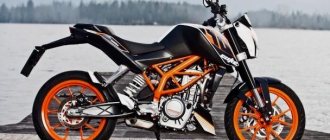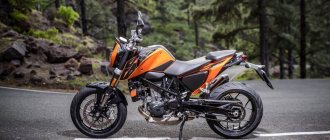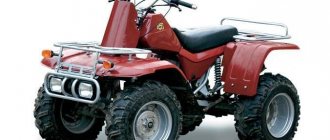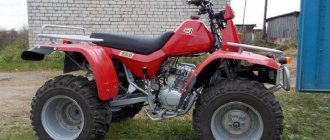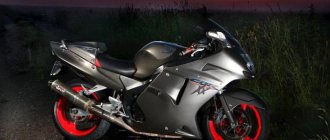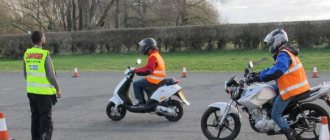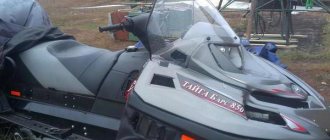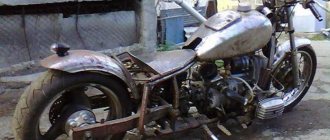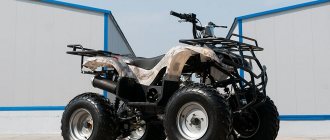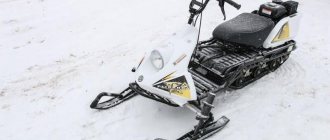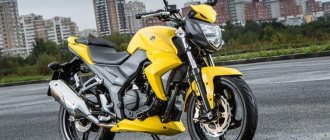Due to its small size and individual appearance, the motorcycle seems overly “teenage” to those who see it for the first time. But in fact, the characteristics of the motorcycle designed by the Austrian KTM designers are very balanced. This bike is distinguished by its versatility, since it feels normal both when driving around the city and on civilized off-road, and, if desired, it can also excite you well on a sports track.
The strength of the bike is its maneuverability in city traffic, where, despite its low power, it outperforms its more “cubic” relatives with sporting roots.
At the same time, the motorcycle does not feel less confident in light off-road conditions. Naturally, riding it will seem dull to an experienced motorcyclist, but for beginners the choice of this bike can be considered ideal.
Possible tuning
This motorcycle has significant potential in terms of upgrades and customizations. At the same time, Duke owners are not limited to a simple “facelift”; much more often they engage in the following types of tuning:
- Replacing the stock rear fender with a more aggressive one (you can find high-quality and inexpensive products for this bike). This allows you to transform the device and make it more sporty and aggressive.
- Standard mufflers are replaced with titanium ones, which have an increased service life and a unique exhaust sound.
- Experienced motorcyclists advise installing a trunk of an original design; this will allow you to transport small luggage, which means you can go on a short trip.
Those who do not want to change their iron friend, but want to get more adrenaline from it, are reconfiguring the fuel system, which makes it possible to increase the maximum speed by another 15 km/h. The motorcycle has a fairly stiff suspension, so such an upgrade will not affect the stability and controllability of the device.
Engine and transmission
The motorcycle is equipped with a single-cylinder 4-stroke liquid-cooled engine. Its working volume reaches 372 cm³, the compression ratio is 12.6:1, so it’s better not to skimp on gasoline, “God grant that my powerful engine does not wither” ©. The pistons are short-stroke, with a diameter of 89 and a stroke of 60 mm. However, the KTM Duke 390 engine is not a boring 250; the differences from the younger version are not only in the CPG, but also in the crankcase.
The fuel supply system is represented by a Bosch EFI injector with a 46 mm gate. Ignition is from the same manufacturer, electronic processor.
The engine power of the KTM Duke 390 reaches 44 hp. at 9500 rpm, and then drops to 40 hp, so turning it to the cutoff makes sense only when accelerating to maximum speed. Torque is 35 Nm at 7250 rpm.
Transmission - 6-speed manual, with dog clutches and wet clutch in an oil bath. The transmission to the wheel is chain, the gear ratio is 15:45.
Analogs
Duke occupies a leadership position in the very popular niche of motorcycles with an engine capacity of up to 400 cc. Its direct competitors are: Kawasaki Ninja 300, Honda CBR 300 R and “identical brother” KTM RC 390. Compared to these models, Duke has the following advantages:
- Low weight.
- Excellent management.
- Stiff suspension.
Flaws:
- Tight clutch.
- Very short passes.
- Vibrations.
In most cases, the main target audience of Duke's share are beginner motorcycle enthusiasts with minimal experience. Most often, a purchase is provoked by watching one video review on the Internet, since the potential buyer is told about excellent handling and sufficient power reserves for dynamic driving.
The general advantages of the model include a comfortable fit, intuitive layout of controls, an informative dashboard and an excellent braking system with ABS.
Construction and chassis
The motorcycle is based on a “cage” frame welded from round and irregular steel pipes. It is the same as that of the younger “Duke” with a 200 cc engine, so the unification of the models is obvious. The same goes for the suspension. At the front, the bike is equipped with an inverted “telescope” with 43 mm stays, at the rear – a pendulum with a monoshock absorber.
Duke 390 frame © MNNTHBX
The wheels have the same diameter, 17 inches, but are equipped with different tires. The front tire is 110/70 and the rear is 150/60, manufactured by Metzeler. These are pretty cool tires for motorcycles of this class, but it’s not surprising. The KTM Duke 390 produces more than 40 “horses”, so it doesn’t need any wheels. The tread is road type, with a shallow herringbone pattern, which is quite standard for motorcycles with a hint of sport.
Braking is handled by Brembo ByBre discs, one each at the front and rear. The front has a diameter of 320 mm, the rear – 230. The number of pistons in the calipers is four and one, respectively. There is an ABS system manufactured by Bosch (9MB). Some people may not find the brakes too impressive, but since the bike is not very heavy, they are sufficient.
Brakes © revzilla.com
The length of the KTM Duke 390 is exactly 2 meters, the width along the handlebars is 87 cm, the height is 1.25 m, the landing is 80 cm. The wheelbase is 1357 mm. It’s the dimensions of the bike that may raise questions. It was clearly designed for a rider of average height. If your height has exceeded 180 cm, the landing may be uncomfortable.
In particular, the aerodynamic “fairings” on the sides of the tank raise questions. A tall person runs the risk of resting his knees on them, and then he will have to forget about the convenience of a long ride and the aerodynamics thought out by the manufacturer.
Knees close © revzilla.com
The weight of the KTM Duke 390 cannot be called light, but 1.5 quintals (without fuel) is normal for a 400 cc bike. Some budget classmates are approaching the 200 mark, or even slightly exceeding it. The tank holds 13.5 liters of gasoline, that is, the curb weight of the bike is about 160 kg.
KTM RC 390 - motorcycle review
Finally, rational thinking has come to modern society when choosing a sports motorcycle. The time when it was appropriate to use a sportbike in various areas of life is long gone, and therefore the demand for these devices is proportionally decreasing. But despite everything, there are still those people who still use the bike not only for racing needs. Actually, you need to figure out whether such an experiment is necessary for a beginner, and also how to still find the right option among so many low-capacity options?
At the end of the 90s, the choice of sports bikes was not so great; there were mainly Japanese 10-15 year old bikes. But after some time, the situation partially changed, after the import of such small sports motorcycles as the Kawasaki Ninja 250R and Honda CBR 250R. Of course, the old bikes were several times superior to the new small motorcycles, but at the same time, these new “checks” also had their undeniable positive qualities, the main one of which was considered the absence of any problems with spare parts, service, and also the purchase of a new motorcycle.
When promoting the idea of small-capacity motorcycles, KTM took as a basis the 390 Duke model, which is rightfully considered one of the world's bestsellers. Before sending the KTM RC 390 to the exhibition, the motorcycle was tested in the ADAC Junior Cup powered by monocup.
The motorcycle has a power of 44 horsepower and is equipped with a 4-valve 373 cc 1-cylinder engine. The Austrians did a pretty good job on this model, making its engine not only powerful, but also surprisingly light. The KTM RC 390 engine weighs only 36 kg.
In addition, the bike is surprisingly narrow in the area of the seat and tank, and begins to widen only as it approaches the front fairing, where the mirrors with an integrated turn indicator are like splayed mustaches.
A tall driver with a large build has nothing to do on this bike, since it is mainly adapted for a person of average height and weight. Actually, the motorcycle is designed mainly for young amateurs who are just learning to ride a sports motorcycle. In addition, the sale of bikes was aimed more at Asia, but at the same time it can attract domestic lovers of speed and adrenaline.
If we talk about its affiliation, then to a greater extent it can be considered a racing motorcycle, but at the same time you can easily use it as a city vehicle, because it has quite adequate and obedient steering, quite a high footrest, and, of course, hard upholstery and low clip-ons.
Are you used to riding with a friend in the back seat? Designers can also please this contingent of people, because there is a small rear seat made of material that imitates sports plastic.
But as we said just above, and judging by the index of the name of the RC (Race Competition) motorcycle, one can understand that it was not originally created for city streets. However, we strongly do not recommend taking this bike to a huge race track first. Before the big start, you should get to know your figurative “friend” more and understand what he is actually capable of. A small karting track that does not have high-speed sections can reveal its full potential. On small but quite twisty turns, this handsome man will show and reveal his full potential, and will also be able to teach you some tricks and knowledge about piloting a bike.
The brilliant 390 design will help you in mastering new turns of motorcycle piloting, according to the best and most importantly proven recipe from the best “chefs in the kitchen of creating motorcycles”:
- frame in the form of gratings made of steel pipes;
- inverted telescopic WP fork;
- and, of course, a WP monoshock absorber with adjustable spring preload.
I would also like to note that the Austrians were able to fit this bulky standard set into the combination of the lightness of the motorcycle, which weighs only 147 kg. Its lightness gives this “stallion” even greater turning and controllability.
The visually compact “stallion” is capable of taking completely different turns thanks to the narrow but quite grippy MSM5 tires (Metzeler Sportec M5), which allow the bike to tilt up to the pegs, and are also able to roll out the rubber profile almost to the edge. MSM5 tires are provided as standard on the KTM RC 390.
We cannot remain silent about the motorcycle’s braking system, in which the front wheel is equipped with a single brake disc along with a 4-bearing Bybre mechanized system, and the rear wheel has a single-piston caliper. In addition, the motorcycle was equipped with an ABS system, which adds confidence that the braking system works quite effectively and clearly, as the driver needs it.
Some people have a picky opinion about this bike due to the operation of the motor, namely its torque. The RC390 engine is a 373 cc single-barrel engine producing 35 Nm of torque, which provides excellent acceleration dynamics at around 7250 Nm/min. If you are driving around the city, then this will be quite enough for you. The main pickiness on its engine comes precisely in track conditions, where acceleration is needed at such a mark much more and at a level higher at revs.
We must not forget about the “twisted” torque up to 9500 rpm. The noticeable vibration allows us to conclude that it is most pleasant to use only the “lows” and “middles”.
Another good feature of the bike is that it can easily be used for engine braking - releasing the gas, which gives predictably clear and at the same time fast braking. It is especially good to do this on this single-cylinder motorcycle in tandem with the PASC slipper clutch, which the developers decided to start installing this year on their new motorcycle models.
Once you understand that this motorcycle does not have any potential, then, of course, you should go to the KTM PowerPart catalog, since the Austrians often update their production, and, of course, offer you an additional set of options and tuning for an upgrade your "friend" on racing and city tracks. The parts offered in their catalog will help make your track sessions the most fun and fastest.
If we ask the question of its operation in the city, then this compact monster is still inferior to many of its class competitors. It is inferior even to its closest sibling, the KTM 390 Duke.
At the end of the article, we would like to talk about whether it can still become part of the big racing world, or can it be limited only to the karting track? As we said above, first you need to recognize your “comrade” by sight, and only then get into the fire. For big races, this model will be useful only if you know what maneuvers with it will have a winning effect on a particular section of the track.
Tips for a beginner motorcyclist || The story of motorcycle legend JAWA.
Related posts:
Yamaha XSR900 motorcycle reviewIn the section: Moto newsThe Yamaha XSR900 is a standard modern motorcycle that would be most suitable for city riding. | BMW R1200R and R1200RS – debut of fresh German new products in CologneIn the section: Moto newsThe Bavarian company BMW Motorrad brought several modernized representatives of its model range to the Intermot event. |
II stage of the competition OFF ROAD Ural Windfall 2015In the section: Competitions and eventsStage II of the off-road sprint competition: “OFF ROAD: Ural Windbreak 2015” This time, the fight against the elements will be on snow, however, there will be special tracks… | Harley Davidson Electra Glide Ultra Classic ReviewIn the section: Moto newsHarley Davidson has always produced motorcycles that later became legends. HD Electra Glide Ultra Classic is no exception. The electric train is a chic representative of hot rod baggers, ... |
Polaris RZR PRO XP 4 2022 – interior design featuresIn the section: Moto newsPolaris RZR PRO XP 4 2022 is a comfortable buggy for traveling and long trips. Roomy and compact, quite reliable, the external design is well designed. | Yamaha VX CruiserIn the section: Jet skisYamaha VX Cruiser is the best version of a jet ski, which is simply perfect for long-distance water trips or walks. |
Dynamics and features of the KTM Duke 390
The motorcycle is not too daring: putting the bike “on the goat” at the start or sharply rushing forward at a traffic light, overtaking everyone and everything, will not work. You can “do a hundred” on a motorcycle in about 5.7 seconds. Big sportbikes do this twice as fast, but the KTM Duke 390 is in a different weight category in which such performance can be called decent. The maximum speed is about 170 km/h, so you can drive it on the track.
As befits a modern motorcycle, the KTM Duke 390 has an electronic instrument panel based on an LCD screen, LED lighting, and advanced on-board electronics. It is not replete with digital systems, but it does not lag behind the times.
Headlights and steering wheel © revzilla.com
Among other features, it is worth highlighting the already mentioned ABS and electronic ignition. There is a PASC slip system in the clutch. But the negative feature of the KTM Duke 390 is the non-adjustable suspension stiffness. It is especially felt when driving quietly on not the best roads.
Steering wheel and instruments © revzilla.com
